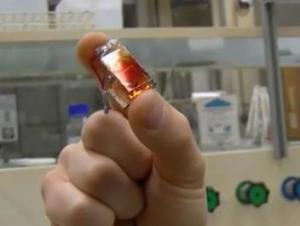
How can solar energy be stored so that it can be available any time, day or night, when the sun shining or not? EPFL scientists are developing a technology that can transform light energy into a clean fuel that has a neutral carbon footprint: hydrogen. The basic ingredients of the recipe are water and metal oxides, such as iron oxide, better known as rust. Kevin Sivula and his colleagues purposefully limited themselves to inexpensive materials and easily scalable production processes in order to enable an economically viable method for solar hydrogen production. The device, still in the experimental stages, is described in an article published in the journal Nature Photonics.
 The idea of converting solar energy into hydrogen is not a new one; researchers have been working on it for more than four decades. During the 1990s, EPFL joined the fray, with the research of Michaël Grätzel. With a colleague from University of Geneva, he invented the photoelectrochemical (PEC) tandem solar cell, a technique for producing hydrogen directly from water. Their prototypes shared the same basic principle: a dye-sensitized solar cell -- also invented by Michael Grätzel -- combined with an oxide-based semiconductor.
The idea of converting solar energy into hydrogen is not a new one; researchers have been working on it for more than four decades. During the 1990s, EPFL joined the fray, with the research of Michaël Grätzel. With a colleague from University of Geneva, he invented the photoelectrochemical (PEC) tandem solar cell, a technique for producing hydrogen directly from water. Their prototypes shared the same basic principle: a dye-sensitized solar cell -- also invented by Michael Grätzel -- combined with an oxide-based semiconductor.
The device is completely self-contained. The electrons produced are used to break up water molecules and reform the pieces into oxygen and hydrogen. In the same liquid, two distinct layers in the device have the job of generating electrons when stimulated by light; an oxide semiconductor, which performs the oxygen evolution reaction, and a dye-sensitized cell, which liberates the hydrogen.
The most expensive part? The glass plate
The team's latest prototype focused on resolving the main outstanding problem with PEC technology: its cost. "A U.S. team managed to attain an impressive efficiency of 12.4%," says Sivula. "The system is very interesting from a theoretical perspective, but with their method it would cost 10,000 dollars to produce a 10 square centimeter surface."
So the scientists set themselves a limitation from the start -- to use only affordable materials and techniques. It wasn't an easy task, but they managed. "The most expensive material in our device is the glass plate," explains Sivula. The efficiency is still low -- between 1.4% and 3.6%, depending on the prototype used. But the technology has great potential. "With our less expensive concept based on iron oxide, we hope to be able to attain efficiencies of 10% in a few years, for less than $80 per square meter. At that price, we'll be competitive with traditional methods of hydrogen production."
The semiconductor, which performs the oxygen evolution reaction, is just iron oxide. "It's a stable and abundant material. There's no way it will rust any further! But it's one of the worst semiconductors available," Sivula admits.
Silicon-enhanced nano-rust
That's why the iron oxide used by the team is a bit more developed than what you'd find on an old nail. Nanostructured, enhanced with silicon oxide, covered with a nanometer-thin layer of aluminum oxide and cobalt oxide -- these treatments optimize the electrochemical properties of the material, but are nonetheless simple to apply. "We needed to develop easy preparation methods, like ones in which you could just dip or paint the material."
The second part of the device is composed of a dye and titanium dioxide -- the basic ingredients of a dye-sensitized solar cell. This second layer lets the electrons transferred by the iron oxide gain enough energy to extract hydrogen from water.
An outstanding potential -- up to 16%
The results presented in the Nature Photonics paper represent a breakthrough in performance that has been enabled by recent advances in the study of both the iron oxide and dye-sensitized titanium dioxide, and both of these technologies are rapidly advancing. Sivula predicts that the tandem cell technology will eventually be able to attain an efficiency of 16% with iron oxide, while still remaining low cost, which is, after all, the attractiveness of the approach. By making it possible to store solar energy inexpensively, the system developed at EPFL could considerably increase the potential of solar energy to serve as a viable renewable energy source for the future.

 Previous page
Previous page Back to top
Back to top







